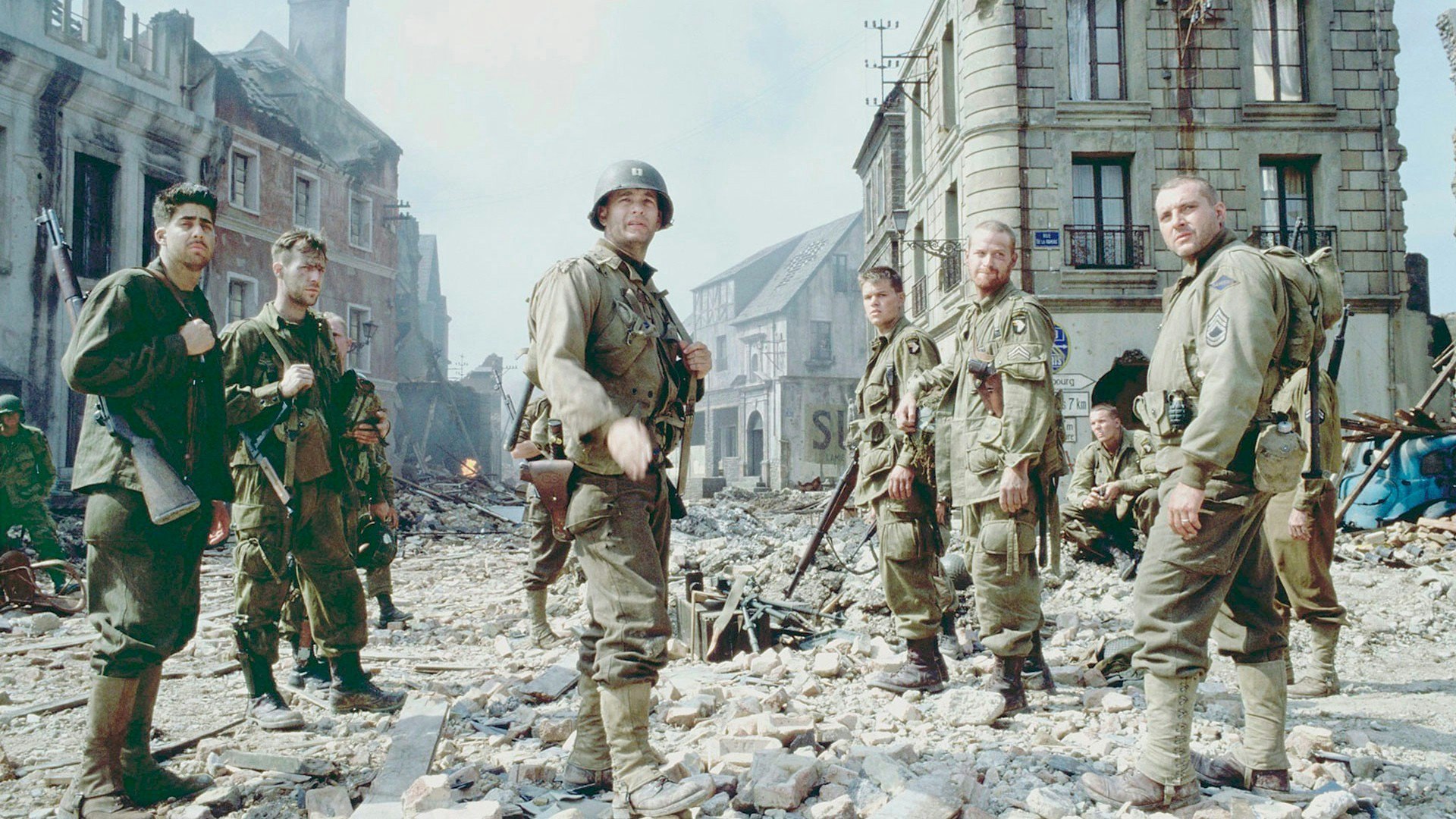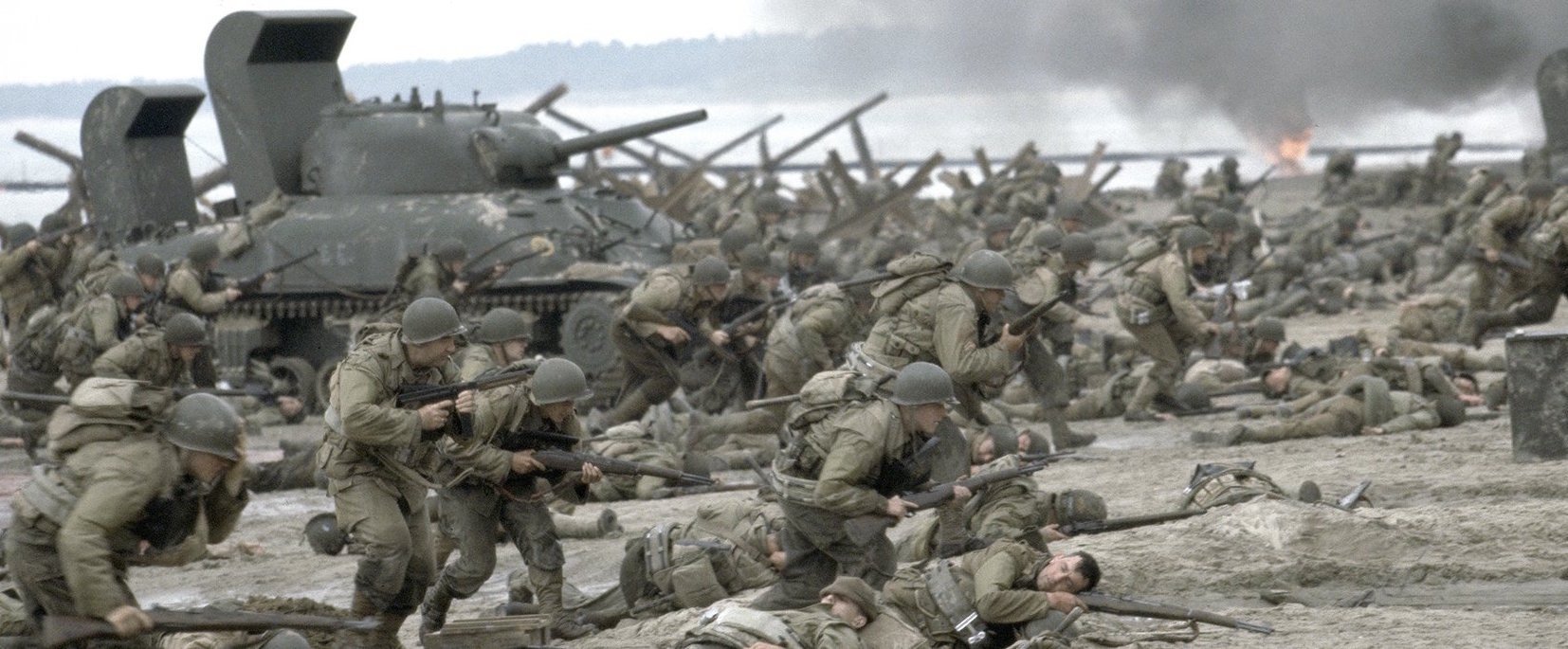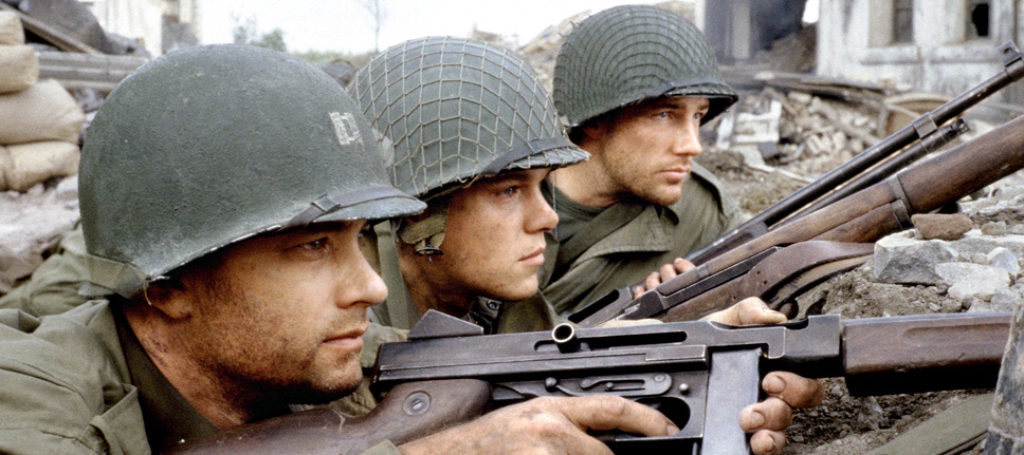Saving Private Ryan: A Cinematic Triumph in Depicting the Brutal Realities of War
 Saving Private Ryan, directed by Steven Spielberg and released in 1998, stands as a monumental achievement in the realm of war cinema. Set during the invasion of Normandy in World War II, the film is a visceral and unflinching portrayal of the brutality, sacrifice, and camaraderie inherent in warfare. With its groundbreaking cinematography, stellar performances, and poignant storytelling, Saving Private Ryan not only captivates audiences but also serves as a profound exploration of the human condition amidst the chaos of battle.
Saving Private Ryan, directed by Steven Spielberg and released in 1998, stands as a monumental achievement in the realm of war cinema. Set during the invasion of Normandy in World War II, the film is a visceral and unflinching portrayal of the brutality, sacrifice, and camaraderie inherent in warfare. With its groundbreaking cinematography, stellar performances, and poignant storytelling, Saving Private Ryan not only captivates audiences but also serves as a profound exploration of the human condition amidst the chaos of battle.
At the heart of Saving Private Ryan lies its harrowing opening sequence—the depiction of the Omaha Beach landing. From the moment the ramp drops on the landing craft, Spielberg plunges the audience into the chaos and carnage of war. The relentless onslaught of bullets, explosions, and screams is captured with a raw intensity that is both staggering and immersive. Through the use of handheld cameras, desaturated colors, and frenetic editing, Spielberg creates an atmosphere of visceral realism, placing viewers squarely in the midst of the blood-soaked sands of Omaha Beach. One of the most striking aspects of the Omaha Beach sequence is its unflinching portrayal of the human cost of war. As soldiers are cut down by enemy fire, their bodies torn apart by bullets and shrapnel, Saving Private Ryan refuses to glamorize or romanticize the violence of combat. Instead, it presents war in all its horrifying brutality, forcing audiences to confront the grim realities faced by those who fought and died on the front lines. The sequence is a testament to Spielberg's skill as a filmmaker, as well as his commitment to honoring the sacrifices of those who served.
One of the most striking aspects of the Omaha Beach sequence is its unflinching portrayal of the human cost of war. As soldiers are cut down by enemy fire, their bodies torn apart by bullets and shrapnel, Saving Private Ryan refuses to glamorize or romanticize the violence of combat. Instead, it presents war in all its horrifying brutality, forcing audiences to confront the grim realities faced by those who fought and died on the front lines. The sequence is a testament to Spielberg's skill as a filmmaker, as well as his commitment to honoring the sacrifices of those who served.
Central to the film's narrative is the mission to save Private James Ryan, a paratrooper whose three brothers have been killed in action. Played with understated vulnerability by Matt Damon, Ryan becomes the focal point of a small band of soldiers led by Captain John Miller, portrayed with stoic resolve by Tom Hanks. As Miller and his men venture behind enemy lines in search of Ryan, they grapple with questions of duty, morality, and the value of one man's life in the midst of a war that has claimed so many. The dynamic between Miller and his squad forms the emotional core of Saving Private Ryan. Each member of the team, from the seasoned veterans to the fresh-faced recruits, brings their own perspective and experiences to the mission. Through their interactions and dialogue, Spielberg explores themes of brotherhood, sacrifice, and the bonds that form between soldiers in the crucible of war. Whether sharing moments of levity amid the chaos or facing the sobering realities of combat, the characters in Saving Private Ryan feel authentic and fully realized, thanks in no small part to the exceptional performances of the cast.
The dynamic between Miller and his squad forms the emotional core of Saving Private Ryan. Each member of the team, from the seasoned veterans to the fresh-faced recruits, brings their own perspective and experiences to the mission. Through their interactions and dialogue, Spielberg explores themes of brotherhood, sacrifice, and the bonds that form between soldiers in the crucible of war. Whether sharing moments of levity amid the chaos or facing the sobering realities of combat, the characters in Saving Private Ryan feel authentic and fully realized, thanks in no small part to the exceptional performances of the cast.
Beyond its visceral action and compelling characters, Saving Private Ryan is also a masterclass in visual storytelling. Spielberg's meticulous attention to detail is evident in every frame, from the grimy uniforms and worn equipment of the soldiers to the devastated landscapes of war-torn France. The cinematography, by the legendary Janusz Kamiński, is both breathtaking and haunting, capturing the beauty and horror of the battlefield with equal measure. Whether sweeping panoramic shots or intimate close-ups, each frame of Saving Private Ryan is infused with a sense of purpose and meaning, drawing the audience deeper into the world of the film. In addition to its technical prowess, Saving Private Ryan is also notable for its historical accuracy and attention to detail. Spielberg and his team went to great lengths to recreate the sights and sounds of World War II, consulting with veterans, historians, and military experts to ensure authenticity in every aspect of the production. From the design of the uniforms and weapons to the layout of the battlefield itself, the film's commitment to realism is evident throughout, lending it a sense of authenticity and gravitas that few war films can match.
In addition to its technical prowess, Saving Private Ryan is also notable for its historical accuracy and attention to detail. Spielberg and his team went to great lengths to recreate the sights and sounds of World War II, consulting with veterans, historians, and military experts to ensure authenticity in every aspect of the production. From the design of the uniforms and weapons to the layout of the battlefield itself, the film's commitment to realism is evident throughout, lending it a sense of authenticity and gravitas that few war films can match.
Ultimately, what sets Saving Private Ryan apart from other entries in the genre is its unwavering commitment to portraying the human cost of war. Through its unflinching depiction of combat, its nuanced exploration of character and morality, and its stunning visual craftsmanship, the film offers a powerful and sobering meditation on the nature of conflict and the resilience of the human spirit. As the credits roll and the echoes of battle fade away, Saving Private Ryan stands not only as a cinematic masterpiece but also as a timeless tribute to the courage and sacrifice of those who served.
Furthermore, Saving Private Ryan extends beyond its portrayal of the battlefield to explore the psychological toll of war on its characters. The film delves into the moral complexities of the mission to save Private Ryan, raising thought-provoking questions about the value of one man's life versus the greater good of the mission. As Captain Miller and his squad risk their lives to locate Ryan, they confront their own doubts and inner conflicts, grappling with the weight of their decisions and the uncertainty of their fate.
This internal struggle is exemplified in the character of Captain Miller, whose quiet leadership and unwavering determination mask a deeper sense of disillusionment and anguish. Tom Hanks delivers a masterful performance, imbuing Miller with a sense of world-weariness and vulnerability that adds depth and complexity to the character. Through his interactions with his men and his internal monologues, Miller emerges as a symbol of resilience in the face of adversity, embodying the courage and sacrifice of those who fought in World War II.
Similarly, the other members of Miller's squad each wrestle with their own demons as they navigate the chaos of war. From the cynical and battle-hardened Sergeant Horvath, played with gruff authenticity by Tom Sizemore, to the naïve and idealistic Private Jackson, portrayed with quiet intensity by Barry Pepper, each character brings a unique perspective to the story, reflecting the diverse experiences and personalities of the soldiers who fought in World War II. It is this depth of character and complexity of emotion that elevates Saving Private Ryan above mere spectacle and transforms it into a profound meditation on the human condition. As the members of Miller's squad face unimaginable hardship and loss, they are forced to confront their own mortality and the fragility of life itself. In doing so, they discover a shared sense of purpose and camaraderie that transcends the horrors of war, forging bonds that will endure long after the battle is over.
It is this depth of character and complexity of emotion that elevates Saving Private Ryan above mere spectacle and transforms it into a profound meditation on the human condition. As the members of Miller's squad face unimaginable hardship and loss, they are forced to confront their own mortality and the fragility of life itself. In doing so, they discover a shared sense of purpose and camaraderie that transcends the horrors of war, forging bonds that will endure long after the battle is over.
Of course, no discussion of Saving Private Ryan would be complete without mention of its iconic and unforgettable score, composed by the legendary John Williams. From the haunting strains of the main theme to the pulse-pounding crescendos of the action sequences, Williams' music serves as the perfect complement to Spielberg's visuals, heightening the emotional impact of each scene and imbuing the film with a sense of grandeur and poignancy.
In conclusion, Saving Private Ryan is a cinematic triumph in every sense of the word. From its groundbreaking cinematography and stellar performances to its profound storytelling and emotional depth, the film stands as a timeless masterpiece that continues to resonate with audiences more than two decades after its release. Through its unflinching portrayal of the brutality of war and its exploration of the human spirit in the face of adversity, Saving Private Ryan reminds us of the sacrifices made by those who came before us and inspires us to strive for a better, more peaceful world. In doing so, it takes its rightful place among the greatest war films ever made, a testament to the power of cinema to illuminate the darkest corners of the human experience and find beauty amidst the chaos.


















































